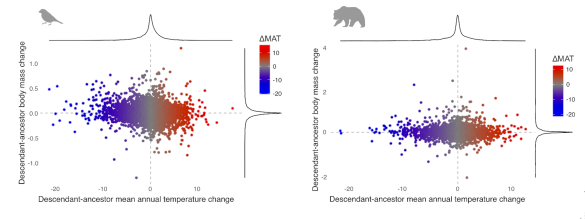Bergmann's rule
June 3, 2024
Animal size varies over a large range as
evolution fills every
ecological niche. Focusing our attention on the range of mass of
land mammals, the smallest is the
Etruscan shrew (1.8
grams), and the largest is the
African bush elephant (6,500
kilograms). Some
megafauna that existed about 40
million years ago had a
mass up to 10,000 kilograms. The largest of these animals were
Paraceratheriidae long-limbed,
hornless rhinocerotoids, and
Proboscidea (
extinct elephants).
As
Galileo Galilei (1564-1642) wrote in his 1638 book,
Discourses and Mathematical Demonstrations Relating to Two New Sciences,
mechanics applies to living as well as non-living
materials. The
square-cube law, which relates a material's
surface area and
volume, and may have been an inspiration for the
spherical cow model, describes the reason why a large
structure can't be just an
enlarged version of a smaller structure.
Large animals are
proportioned differently from smaller animals. For example, if an elephant were proportioned as a
mouse, it would be a very
weak animal. That's because the
cross-section of its
muscles would increase by the
square of its size, while its mass would increase by its
cube. The
movie monster giants, such as
King Kong[1] and the giant
ants from
Them!,[2] could not exist, since they are just scaled versions of their smaller
counterparts,
gorilla and ants.

Movie poster by Reynold Brown (1917-1991) for Attack of the 50 Foot Woman (1958) starring Allison Hayes (1930-1977).[3]
Because of the square–cube law, a fifty foot woman would not appear as comely as her human-sized counterpart.
(Movie poster for Attack of the 50 Foot Woman, via Wikimedia Commons. Click for larger image.)
Bergmann's rule is another rule involving animal size. It was stated by
German biologist,
Carl Bergmann (1814-1865), in 1847, and it applies to
homeothermic (for example,
warm-blooded) animals. This
correlation is most apparent for animals above a certain size, since small animals can have
adaptations, such as
burrowing to protect from
cold. In this rule,
species within a
genus have a larger size in cold
environments, and smaller size in warmer environments. Bergmann's rule is often generalized to
populations within a species, and
latitude is used as an
alias for
temperature.
Interestingly, temperature changes during some
geological periods have caused a temporary, reversible
dwarfing of mammals. Bergmann's rule applies to
humans, as can be seen in the difference between the large body size of the
Inuit,
Aleut, and
Sami people of the
polar regions, and the small body size of
pygmy people of
Africa.
Bergmann
theorized that the same reasoning of the square-cube law applies to this rule. In this case, body volume predicts the degree of
metabolism that leads to
generation of body heat, while the surface area predicts how much of that heat is lost. As a consequence, larger animals
radiate less body heat per unit of mass, and they will stay warmer in cold
climates, and smaller animals have a proportionately larger surface area that allows more cooling. It's been noted that temperature also has an affect on
food availability, and this would cause an
evolutionary pressure for smaller body size.
Bergmann's rule has been questioned in a recent
study by
scientists from the
University of Alaska Museum (Fairbanks,Alaska), the
University of Alaska, Fairbanks (Fairbanks,Alaska), the
University of Reading (Reading, UK),
Montana State University (Bozeman, Montana) the
University of Bristol (Bristol, UK), the
Chinese Academy of Sciences (Beijing, China), and
Florida State University (Tallahassee, Florida).[4-5] This study began with the question of whether Bergmann's rule applied to
dinosaurs posed to her
undergraduate advisor by Lauren Wilson,
first author of the
paper describing this
research.[5]
The study used
data for 62
Mesozoic mammaliaforms and 339 dinosaurs, including the the northernmost discovered dinosaur
fossils from the
Late Cretaceous Prince Creek Formation of northern
Alaska.[4-5] Such dinosaurs experienced
freezing temperatures and
snowfalls in their
lifetimes, but the study found no notable increase in body size for any of the
Arctic dinosaurs.[5] The Mesozoic dinosaurs and the ancient mammaliaforms were the
ancestors of extant homeothermic birds and mammals.[4] Says University of Alaska, Fairbanks
graduate student, Lauren Wilson,
We found that Bergmann's rule is only applicable to a subset of homeothermic animals (those that maintain stable body temperatures), and only when you consider temperature, ignoring all other climatic variables. This suggests that Bergmann's ‘rule' is really the exception rather than the rule."[5]
As a further part of their study, the research team analyzed Bergmann's rule for
modern mammals and birds, the descendants of extinct mammals and dinosaurs, and found that latitude was not a
predictor of body size for these species.[5] They did find a small relationship between the body size of modern birds and temperature, but not for Mesozoic birds.[4-5] This suggests that body size in modern birds was influenced by Bergmann's rule during climatic change in the Cenozoic.[4]

mean annual temperature and body size evolution among extant birds and mammals. On the left is the estimated branch-wise changes in body mass on a logarithmic scale as a function of mean annual temperature (°C) along branches of the avian phylogeny. On the right, the same data analysis along branches of the mammalian phylogeny. No apparent trend is noted in either. (Portions of fig. 3 of ref. 4,[4] released under the Creative Commons Attribution 4.0 International License. Click for larger image.)
References:
- King Kong (1933), Merian C. Cooper and Ernest B. Schoedsack, Directors, on the Internet Movie Database.
- Them! (1954), Gordon Douglas, Director, on the Internet Movie Database.
- Attack of the 50 Foot Woman (1958), Nathan Juran, Director, on the Internet Movie Database.
- Lauren N. Wilson, Jacob D. Gardner, John P. Wilson, Alex Farnsworth, Zackary R. Perry, Patrick S. Druckenmiller, Gregory M. Erickson, and Chris L. Organ, "Global latitudinal gradients and the evolution of body size in dinosaurs and mammals," Nature Communications, vol. 15, Article no. 2864 (April 5, 2024), https://doi.org/10.1038/s41467-024-46843-2. This is an open access article with a PDF file available at the same URL.
- Marmian Grimes, "Dinosaur study challenges Bergmann's rule," University of Alaska Fairbanks Press Release 173-24, April 5, 2024.
Linked Keywords: Animal; evolution; ecological niche; terrestrial animal; land mammal; Etruscan shrew; gram; African bush elephant; kilogram; megafauna; Mya; million years; mass; Paraceratheriidae; limb (anatomy); long-limbed; horn (anatomy); hornless; rhinocerotoids; Proboscidea; extinction; extinct; elephant; Galileo Galilei (1564-1642); Discourses and Mathematical Demonstrations Relating to Two New Sciences; mechanics; material; square-cube law; surface area; volume; spherical cow; scientific modelling; model; structure; linear scale; enlarged; body proportions; proportioned; mouse; muscle weakness; weak; cross section (geometry); muscle; exponentiation square; exponentiation cube; monster movie; movie monster; giant; King Kong; ants; Them!; counterpart; gorilla; Movie poster for 'Attack of the 50 Foot Woman'; movie poster; Reynold Brown (1917-1991); Attack of the 50 Foot Woman (1958); Allison Hayes (1930-1977); woman; comely; human-sized; Wikimedia Commons; Bergmann's rule; German; biologist; Carl Bergmann (1814-1865); homeothermy; homeothermic; warm-blooded; correlation; adaptation; burrow; burrowing; cold; species; genus; environment (biophysical); population genetics; population; latitude; alias; temperature; geologic time scale; geological period; dwarfing; human; Inuit; Aleuts; Sami people; polar regions of Earth; pygmy people; Africa; theory; theorize; metabolism; thermoregulation; generation of body heat; thermal radiation; radiate; climate; food; evolutionary pressure; research; study; scientist; University of Alaska Museum (Fairbanks,Alaska); University of Alaska, Fairbanks (Fairbanks,Alaska); University of Reading (Reading, UK); Montana State University (Bozeman, Montana); University of Bristol (Bristol, UK); Chinese Academy of Sciences (Beijing, China); Florida State University (Tallahassee, Florida); dinosaur; undergraduate education; undergraduate; advisor; first author; scientific literature; paper; data; Mesozoic; mammaliaforms; fossil; Late Cretaceous; Prince Creek Formation; Alaska; freezing; snow; snowfall; life expectancy; lifetime; Arctic; ancestor; postgraduate education; graduate student; subset; climate; climatic; modern history; modern; prediction; predictor; Mean annual temperature and body size evolution among extant birds and mammals; average; mean; year; annual; temperature; body plan; body size; evolution; extant; bird; mammal; approximation; estimated; taxonomy (biology); branch; logarithmic scale; function (mathematics); Celsius; °C; avian; phylogenetics; phylogeny; data analysis; mammalian; trend estimation; trend; Creative Commons Attribution 4.0 International License; King Kong (1933), Merian C. Cooper and Ernest B. Schoedsack, Directors; Them! (1954), Gordon Douglas, Director; Attack of the 50 Foot Woman (1958), Nathan Juran, Director.